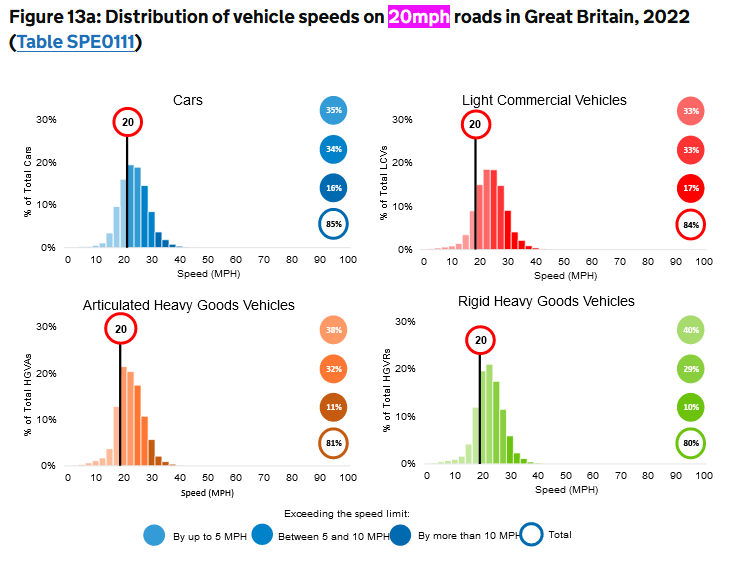- cross-posted to:
- [email protected]
- cross-posted to:
- [email protected]
Statistics published today by the U.K. Department for Transport (DfT) show that in 2022 85% of the car drivers in Great Britain broke the law by driving faster than the speed limit in 20mph zones. On roads with a 30mph maximum, 50% of car drivers broke the law, reveals the annual DfT report on speed limit compliance.
The measurements are based on speed data from a sample of Automatic Traffic Counters (ATCs) around the country. These exclude locations where external factors might restrict driver behavior, such as at junctions, on hills, beside sharp bends or where speed cameras are visible, says the DfT report.
I’ve tried driving at 20mph on some of those roads and you get so much traffic up your arse that it feels dangerous. I assume they just want you to slow down below 30mph. I will say I think it’s a lot more than 85%.
The data shows 70-90%. However, about half are no more than 5 mph over the limit.

It also details the caveat that almost all of the 20 mph roads measured are free-flow areas without traffic calming, and it doesn’t represent the majority of 20 mph roads where traffic calming is present and traffic will naturally be slower. So, basically they’re measuring compliance in 20 mph zones that don’t really feel like 20 mph zones.
Compliance is much better for 30, 60 and 70 mph limits.
So it’s ok to not comply with laws when it feels right?
Well, if it wasn’t for otherwise good citizens breaking laws they know to be wrong, those laws would never get changed.
I don’t think that law is going to get changed by repeatedly breaking it.
I also don’t think it is a bad law. The probability of a pedestrian being fatally injured at 20mph is lower than at 30mph; older studies showed a nearly tenfold reduction; not sure what the figures would be now with the trend towards larger and heavier vehicles (and the offset by pedestrian-friendly design - EuroNCAP score for this). For residential and pedestrian heavy areas I think 20mph is appropriate.
It is also worth bearing in mind that several areas in the UK have already committed to 20mph for residential areas.
I think the more likely outcome is going to be changes to roads and enforcement.
Here’s a .pdf factsheet from RoSPA that looks at 20mph zones.
The only safe way to deal with tailgaters is to slow down gradually. If you fall into the trap speeding up to create more distance, then your braking time will inevitably reduce and they will have less reaction time. This will also result in a harder collision if one occurs.
it’s simple. asking people to do the right thing (i.e slowdown), out of the kindness of their hearts, is laughable.
if you build the street in such a way that driving above it’s design limits is impossible, then people wont do it. surprisingly, the threat of their car being damaged or totaled will force compliance with the intended speed limit. if this was done correctly on a large scale, speed limit posts wouldn’t even be required - the street layout would naturally dictate the speeds you can drive at.
for UK streets, this can be retrofitted with chicanes, curb extensions, raised pedestrian crossings, etc. increasing the amount that a driver has to think to drive down a street, automatically makes them slower. oh, and none of those stupid painted chicanes and bumps either, you think anyone cares about those? lol. actually build the damned curb extensions
deleted by creator
85% of the UK are criminals, I thought Australia was supposed to solve that for us.
My understanding is most 20mph zones are simply advisory, as they don’t have traffic orders.
They are not.
Used to be years ago, but law changed some time in the last few years
There are quite a few caveats in there, like it was usually through roads with no traffic calming measures and they’re often the ones I see people get narked about complying with. I do think some of these should be reconsidered as 30mph.
20mph zones are usually created because of an issue. Either idiots speeding repetitively or some poor sod being hit by a speeding car.
If people are already speeding, lowering the limit will do little.
You are missing the point that speed limits are imposed because of the history of that road or type of road. Councils have a duty of care and must be seen to apply it.
London council was fined because a young child died with asthma. The parent sued because she was not made aware of the problem. She claimed there was not enough information regarding air quality. This is why you see ULEZ in the London area. If some poor kid is hurt by a car and they cannot prove the driver was speeding, then you have to assume the speed limit is too high. This is the culture we have adopted to protect ourselves from libel suites. The speed limit is not applied to piss you off, it is for the protection of others who use the road.
If this is unacceptable to you then write to your council and tell them that you will accept any liability claims for that road if they up the speed limit. You may also need to convince the people who live there, and send their kids out across that road.
Agree with what you said in full.
A lot of the conversation seems to be starting with “I don’t see why it should be 20mph so I’m going to ignore it”. I think your comment goes some way to explaining why this kind of thinking isn’t appropriate.
Roads aren’t just about cars and drivers.
Thanks. People can be very insular when it comes being inconvenienced.
deleted by creator
deleted by creator
deleted by creator
no problem, I will delete the reply.
I’m not missing the point at all. I’m saying that those that already break the rule won’t obey the new rule.
Beside a single car has a driver who is liable. A thousand cars has shared liability in the form of local government. Damage through speeding is a singular liabilty. Damage through air quality is group liability.
You can’t compare the two.
@wewbull
That’s categorical thought, which is an error with a continuous variable such as speed.That they break, or do not break, the law (“rule” doesn’t quite describe it).
You may also care to consider that if one driver does not exceed the limit, it moderates the speed of others behind - you’ve presented this as an individual decision, uninfluenced by others, but even taken as a guideline others have influence.
I am comparing the liability issue and how responsible people react. There is a huge problem with liability claims and costs. People in charge of money need to show they have done due diligence. You are right that some will never obey the rules, but that comes under an SEP (somebody else’s problem). It will no longer be the problem of a council.
How would you ensure compliance?
@wewbull @Syldon
If by speeding you mean 35 in a 30 zone, then will the drivers who know their journey is urgent and important, as are try, and that they are more skillful than those around them, drive 15mph above the limit, or 5mph?They’ll stand out rather more if the former, and have a likelihood of killing a hit pedestrian or cyclist reduced by the change if the latter.
I suspect the chap recently apprehended for 61 in a 30 zone past children might not change, yes.
I don’t think most people are actively engaged when they speed and are rationally thinking about such things. They just travel at a speed which feels “right” for the conditions. Just changing the sign changes nothing for such people as it’s still the same road which has the same feel.
Make them 30mph and then 85% of people will break the new speed limit. Keep it low and at least their speed is likely to be lower.
Edit: This is not true as far as I can tell. Sorry.
This is just wrong. Studies show people drive the speed they feel is safe.
Which is why councils just slapping a 20mph sign on a road isn’t enough.
Unsurprisingly, roads are designed and built with certain speeds in mind, and - excluding national speed limit country roads - this broadly means that the wider the road the faster you’re able to go safely.
If you want an old 30mph road to be 20, and people to actually stick to it, you need to make people less comfortable driving at 30 on that road. Which means making it considerably narrower.
It’s the same reason that 70 can feel incredibly slow on a motorway, but 40 can feel incredibly fast elsewhere.
There’s a road here that’s relatively modern as roads go… it was built when I was a child to take traffic out of the centre. It’s wide, straight and has no houses or anything along it that would attract pedestrians. It was clearly designed and built as a bypass.
The council recently made it 20… I’m still scratching my head (a) why and (b) whether they really expect anyone to take any notice.
But then they’ll leave a road as 30 and cover it with speed bumps… including the main route to the motorway…
Unsurprisingly, roads are designed and built with certain speeds in mind, and - excluding national speed limit country roads - this broadly means that the wider the road the faster you’re able to go safely.
It’s been really driven home (sorry, no pun intended) by me looking after my brother’s house which is on a very long wide, pretty straight road with lots of off-street parking. It and another similar road running at 90 degrees are key connecting roads that form a rectangular box for the area but two are 30mph and two are 20 with no rhyme and reason for it (one of the 30s has a much narrower stretch).
Is one of the roads more popular with cyclists or more likely to have folks crossing? Roads aren’t just for cars.
Yeah they cover that in the report:
On roads with a 30mph maximum, 50% of car drivers broke the law
I mean that’s still too high and there’s no need for it.
edit: I presume the thinking is that if want 30mph, then you say 20 and the average speed is then under 30, which makes sense on small, narrow side streets but less so on the through roads they were surveying.
Most modern cars have speed limiters you can adjust on-the-go. By modern I mean made in the last five years or so.
No excuse for speeding.
If there’s a question of how appropriate a speed limit might be, that’s still not an excuse for speeding - that’s grounds for presenting a case to the local authority and campaigning for change via the legal route.
Residential street speed limits (20mph, 30mph) have to be the most poorly followed laws in the UK.
Edit to add: more expensive cars have had this feature for even longer; operating a vehicle within a given speed constraint with or without technology to help shouldn’t be hard for a competent driver. So: why the downvotes?
Both of my family’s cars are 20 years old.Not everybody is rich.
I brought up the tech because I see a lot of newer cars being driven in violation of the speed limit.
Should still be possible to hold to 20mph, with or without the tech.
Not sure that wee need people fiddling with car controls rather than looking where they are going. I get your point though, but even more cars have Bluetooth. So why are people still holding their phones? Probably because they can’t be bothered or ‘It’s too much faffing about’.
Ware High St was reduced from 30 to 20 a while ago. I don’t know when as it wasn’t that publicised. Loads of people ignore that as well. Speed limit signs the size of a side plate don’t help either. Maybe some massive ‘20 mph’ letters on the road? A few raised areas wouldn’t hurt either.
A lot of these areas have just had 20mph limits slapped on them with no thought or reason.







